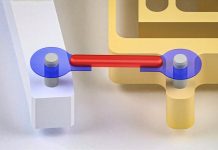
Scientists have created paper-thin “magnetic muscles” that can make tiny origami robots move—opening up exciting new possibilities for delivering medicine inside the human body.
The breakthrough, developed by researchers at North Carolina State University, uses 3D printing to combine flexible rubber-like materials with magnetic particles, producing a film so thin it can be attached to delicate origami structures without limiting their motion.
Dr. Xiaomeng Fang, assistant professor at NC State’s Wilson College of Textiles and lead author of the study published in Advanced Functional Materials, explained that these soft magnetic films act as actuators—components that control motion—when exposed to magnetic fields.
“Traditionally, magnetic actuators use small, hard magnets, like the ones on a refrigerator,” Fang said.
“But our technique lets us print a soft, ultra-thin magnetic film that can move the robot while keeping its lightweight, foldable design.”
The research team designed one robot specifically for delivering medicine to ulcers in the stomach.
Inspired by a folding pattern known as Miura-Ori, the robot can fold into a tiny shape for swallowing and then unfold once it reaches the right location inside the body. The magnetic film helps control the robot’s movement and unfolding.
In lab tests, the researchers placed the robot in a model stomach—a plastic sphere filled with warm water—to mimic real conditions.
Using external magnets, they guided the robot to a target area, unfolded it, and kept it in place with the magnetic film.
Once deployed, the robot slowly released medicine in a steady and controlled way, offering a noninvasive method of treatment that would allow patients to continue their normal activities.
Developing these magnetic muscles was not easy.
The challenge was packing enough ferromagnetic particles into the rubber mixture to create strong magnetic forces.
Normally, adding too many particles prevents the material from hardening properly during printing.
To solve this, the team combined UV light with heat from a hot plate to solidify the material, allowing them to add far more magnetic particles than before. “That was the real breakthrough,” Fang said.
“The more particles we can use, the stronger the magnetic movement becomes.”
The team also built another origami robot that could crawl forward. By placing the magnetic films in specific areas, they made the robot bend and lift as the magnetic field turned on and off, helping it “walk” across different surfaces—even over obstacles up to 7 millimeters high.
According to Fang, these flexible and compact magnetic muscles could one day power many types of origami robots, from medical devices to space exploration tools. “It’s exciting to imagine all the possibilities,” she said.



